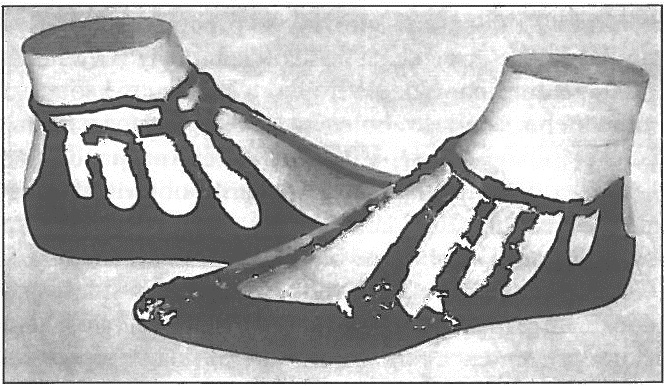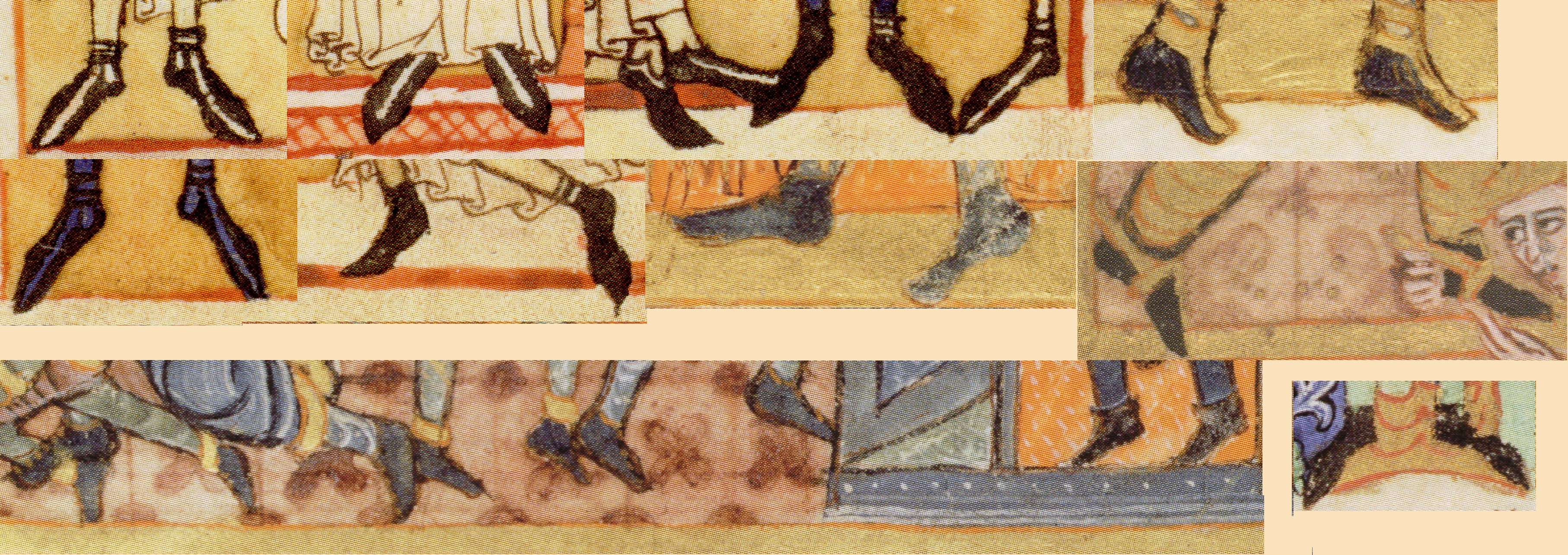Greetings, friends of long past times!
Today I want to present to you an object so important that it deserves to be treated in a separate article. My goal is nothing more than to bring this artifact into wider awareness and outline the possible consequences that flow from it for the reenactor community.
The position of Přerov on the map of Central Europe.
In 1984, the archaeological research of the Upper Town in Přerov, Czech Republic began, which continued with minor breaks until 1990. The first areas explored were plots of original houses no. 8 and 9 in the eastern part of the Upper Town area, where the construction of the Meopta club was planned (Kohoutek 1995: 187). An unique find was made in this area, the upper part of a shoe, which has been described in detail several times (Procházka 2017: 264-6; Shromáždilová 2000: 118-120; Staňa 1999). We will quote its description in full (Procházka 2017: 264-5):
Inv. no. 598/84, area C, layer 341, phase 3.1. Upper part of a leather ankle shoe made of one piece of fine leather, stitched on the outer (left) side in front of the ankle with a vertical 68 mm long seam. The instep cut is 145 mm long, starts from the upper peripheral edge and ends at a distance of about 75 mm from the toe of the shoe. The upper ankle part had a square cut-out at the bottom, its right side extending into three triangular lobes with a length of 49-50 mm and a width of up to 35 mm. At each lobe there is an opening for threading a strap, terminated on both sides with knots. Of the three straps, only the strap at the upper lobe has survived in its entirety, the middle one is missing, and the lower one is incomplete. The shoe was fastened by threading toggles into three trapezoidal leather loops, sewn on the left side of the shoe. The loop was cut in the shape of a T. From the lower right edge of the shoe cutout, a 115 mm long decorative seam ran to the center of the toe, which is only visible on the front side. A lining was probably sewn to the upper part from the reverse side, which could be indicated by the absence of wear marks on the reverse side, as well as stitch marks on the upper edge and on the triangular fastening straps. The lower peripheral edge bears distinct lenticular holes of irregular orientation, made with an awl for the stitches connecting the preserved part to the sole. On the left (outer?) side of the shoe, especially in the area of the heel and toe joints, Ivana Shromáždilová noted significant signs of wear caused by wearing; the inner side lacks similar traces. Assuming it was the left shoe, the wearer stepped more on the outside of the shoe. The lower perimeter of the shoe is slightly folded inward, it is edged with holes for sewing the non-preserved sole. After reconstruction, the shoe is 220 mm long at the level of the sole and its height reaches 140 mm.
For the sake of completeness, it should be added that the shoe is made of tanned cowhide and corresponded to EU size 36 (Procházka 2017: 265-6). The mention of lining is undoubtedly a misunderstanding of the seam on the inside of the top edge.
The upper part of the shoe, inv. no. 598/84. Source: Procházka 2017: 266, Fig. 90.1.
In the Early Middle Ages, the Upper Town of Přerov was part of an agglomeration that stretched on both sides of the Bečva on the territory of today’s Přerov and Předmostí, and which apparently also consisted of the Hradisko and Skalka localities. The agglomeration was already inhabited during the period of Great Moravia, and it seems beyond doubt that the historical core of the town of Přerov (Upper Town) was inhabited at the same time (Kohoutek 1995: 194-5). The shoe found in this locality probably belongs to the layer created artificially immediately before the construction of the massive wood-earth fortification, which, with its hook construction, differs significantly from the previously known early medieval fortifications in Moravia (Kohoutek 1995: 195; Procházka 2017: 265). At this point, it must be emphasized that the construction of the rampart has the closest analogues in the Polish environment and was apparently built at the turn of the 10th and 11th centuries, i.e. at the time when Moravia was annexed to the Polish kingdom by Bolesław the Brave and Přerov became one of the leading Moravian centers. The shoe itself has the closest analogues in Wrocław, Gdańsk and Szczecin in Poland (Kowalska – Dworaczyk 2011: 311; Kaźmierczyk – Kramarek – Lasota 1978: 170-1, Ryc. 45; Wiklak 1960). From the available sources, it seems likely that the dating of the shoe fits into the last decade of the 10th century or the first decade of the 11th century and is directly related to the Polish occupation of Moravia.
The shoe from Přerov represents, as far as I know, one of the oldest and most complete examples of early medieval footwear from the territory of the Czech Republic. In addition to the above-mentioned shoe, other shoe fragments were found in Přerov, a total of 11 fragments of uppers shoe parts and soles were found in no. 8 and 9 in Přerov’s Upper Town (Procházka 2017: 265). In the grave of Boleslaus II, a leather fragment was found at Prague Castle, the analysis of which confirmed that it had been stressed in one direction and is interpreted as the remains of a shoe (Bravermanová 2006: 202). It is assumed that the leather comes from the tongue or wider straps, and we could find shoes of a similar type in royal graves in Germany, for example in the grave of Conrad II in Speyer (Bravermanová 2000: 254). A gilded silver plate was found near Prince Boleslaus’s heel, which apparently came from shoes. Other fragments of footwear in the Bohemian area are known only in the 11th and 12th centuries. Preserved fragments of footwear, which are stitched with gilded bronze wire in a geometric motif, are known from children’s grave no. 7 in Týnec nad Sázavou, dated to the period 1050-1200 (Hejna 1983: 411-2, Fig. 22); these shoes have their closest parallels in Gdańsk and Opole, Poland (Wiklak 1969) and Pskov, Smolensk, and Novgorod, Russia (Izjumova 1959: Рис. 4). Other finds of shoes from 11th-12th century are represented by the decorated shoes of high church dignitaries, for example the silk shoes of Bishop Šebíř, stitched with gold thread (Bravermanová 2003), and the leather shoes of Bishop Menhart (Bažantová 1991). An important source for the study of shoes from Bohemia is also the illuminations of the Wolfenbüttel manuscript (Zachová 2010), which is believed to have been created around the year 1002 (Třeštík 2007: 33). The shoes depicted in it take different forms; some appear to be full shoes with a slit at the upper edge, other shoes are full with significant slits, some shoes have cut-outs – part of the shoes have instep decoration, others have elongated toes, some appear to have decorated upper edges. It is true that the shoes depicted in this manuscript copy the foot. We do not see shoes that could be fastened with buttons in the manuscript.
For reenactors involved in the reconstruction of Great Moravia and Přemyslid Bohemia, the Přerov and Týnec shoes represent important sources that they can refer to when making their own boots. We can see that early medieval Czechs and Moravians were not isolated and used footwear that followed the same trends as in neighboring Poland. I believe that it is the Polish material that can help as an excellent resource when looking for shoes suitable for the reconstruction of early medieval Czechs and Moravians. In particular, the localities of Opole (Hołbowicz 1956: 131-9) and Wrocław (Kaźmierczyk – Kramarek – Lasota 1978), which are located near the Czech border, or relatively old localities, such as Gniezno (Purol-Wierzbicka 2015), can be useful. Another good, but not very well-known source can also be shoes found in Slavic settlements on German territory – the shoe from the Presenchen locality is probably be closest to the Czech lands (Zehmke 2015: 225). Of course, it is also possible to follow more general European trends in the development of footwear (see Volken 2014: 117-131).
Fragment of a shoe or a satchel, inv. no. 596/84, Přerov.
Source: Procházka 2017: 266, Obr. 90.4.
Fragments of shoes stitched with gilded bronze wire. Grave no. 7, Týnec nad Sázavou.
Source: Hejna 1983: Obr. 22.
Conrad II’s slippers, the closest analogy to the slippers found in the grave of Boleslaus II.
Source: Bravermanová 2000: Obr. 3.
Bishop Šebíř’s textile shoe.
Source: Bravermanová 2006: Obr. 6.
Footwear depicted in the Wolfenbüttel manuscript.
Source: Zachová 2010.
Here we will finish this article. Thank you for your time and we look forward to any feedback. If you want to learn more and support our work, please, fund my project on Patreon or Paypal.
Bibliography
Bažantová, Nina (1991). Restaurování pontifikálních střevíců pražského biskupa Menharta. In: Památky a příroda : časopis státní památkové péče a ochrany přírody 16/1, 25-27.
Bravermanová, Milena (2000). Hrob Boleslava II. In: Přemyslovský stát kolem roku 1000 : na paměť knížete Boleslava II. (+ 7. února 999), Praha, 247-260.
Bravermanová, Milena (2003). Pohřební střevíc pravděpodobně biskupa Šebíře. In: Archaeologia Historica 28, 503-524.
Bravermanová, Milena (2006). Textil nejstarších Přemyslovců. In: Sommer, Petr (ed). České země v raném středověku, Praha, 193-212.
Hejna, Antonín (1983). Příspěvek ke studiu malých opevněných sídel doby přemyslovské v Čechách. In: Památky archeologické LXXIV, Praha, 366-436.
Hołubowicz, Włodzimierz (1956). Opole w wiekach X-XII, Katowice.
Kaźmierczyk, J. – Kramarek, J. – Lasota, C. (1978). Badania na Ostrowie Tumskim we Wrocławiu w 1976 roku. In: Silesia Antiqua 20, 123-167.
Izjumova 1959 = Изюмова С. А. (1959) К истории кожевенного и сапожного ремесел Новгорода Великого // Материалы и исследования по археологии СССР, Вып. 65. Труды Новгородской археологической экспедиции, т.II, М., 192-222.
Kohoutek, Jiří (1995). Počátky města Přerova. In: Archaeologia historica 20, 187-200.
Kowalska, A. B – Dworaczyk, M. (2011). Szczecin wczesnośredniowieczny, Warszawa.
Procházka, Rudolf (2017). Hrad Přerov v raném středověku (9. -11. století) a počátky mladohradištní hmotné kultury, Brno.
Purol-Wierzbicka, Monika (2015). Wczesnośredniowieczne wyroby ze skóry z Góry Lecha w Gnieźnie. In: Rocznik Muzeum Początków Państwa Polskiego w Gnieźnie 1, Gnieźno, 136-211.
Shromáždilová, Ivana (2000). Kožedělná výroba v archeologických dokladech středověku. Brno. Diplomová práce. Filozofická fakulta Masarykovy univerzity v Brně.
Staňa, Čeněk (1999). Dva unikátní raně středověké nálezy z Přerova na Moravě (kožený svršek boty a olověné mincovní závaží). In: Archeologické rozhledy 51(4), 760–773.
Třeštík, Dušan (2007). Ještě ke královně Emmě. Wolfenbüttelský rukopis Gumpoldovy legendy a druhý život královny Matyldy. In: Doležalová, E. – Šimůnek, R. (eds.). Od knížat ke králům : sborník u příležitosti 60. narozenin Josefa Žemličky, Praha, 23-37.
Volken, Marquita (2014). Archaeological Footwear: Development of Shoe Patterns and Styles from Prehistory til the 1600’s, Zwolle.
Wiklak, Henryk (1960). Obuwie gdańskie w X-XIII wieku, Gdańsk.
Wiklak, Henryk (1969). Polskie obuwie wczesnosredniowieczne z VIII-XIII w. na podstawie wykopalisk. In: Materialy wczesnosredniowieczne 6, 475-518.
Zachová, Jana (ed.) (2010). Legendy Wolfenbüttelského rukopisu, Praha.
Zehmke, Eric (2015). Die Lederschuhfunde der Brandenburg. In: Grebe, Klaus et al. (eds.). Die Brandenburg im slawischen Mittelalter: Ergebnisse der Ausgrabungen zwischen 1961 und 1983, Wünsdorf, 216-239.






2 Responses
“The most incomplete piece” is that so or is it a typo?
Thank you, that was a typo!